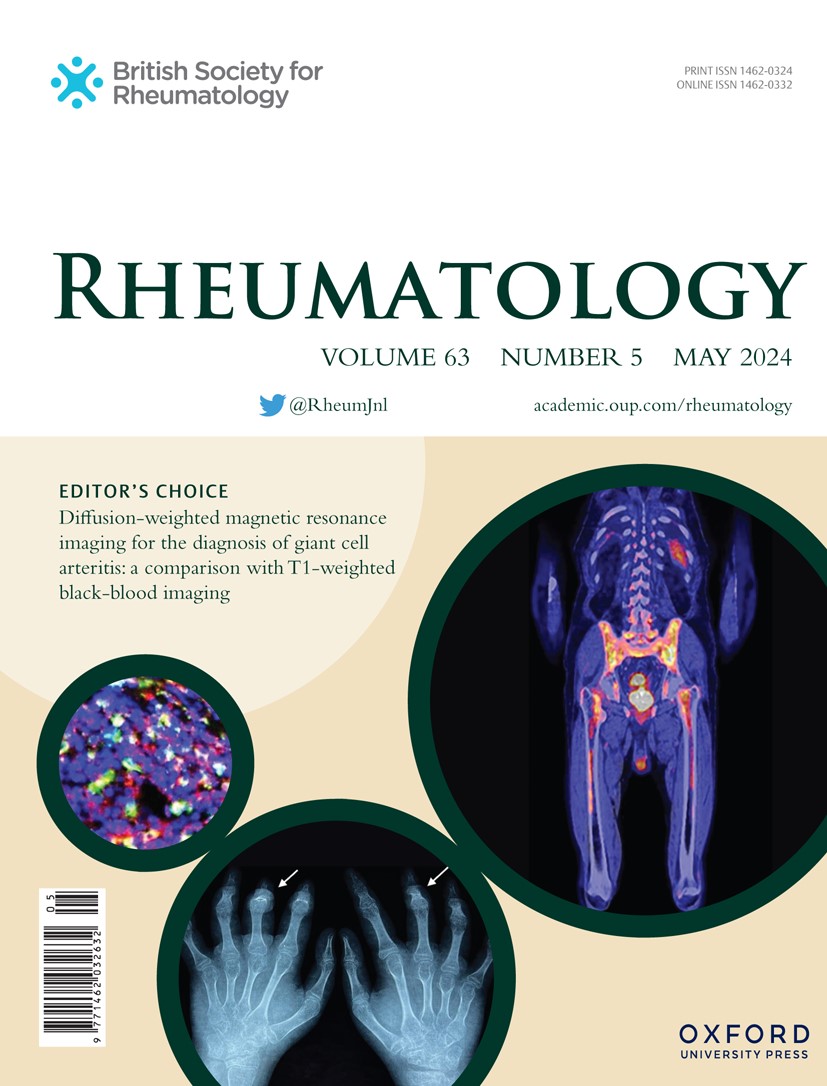高流行的早期损伤独立预测未来的死亡率在高松动脉炎的初始队列。
IF 4.4
2区 医学
Q1 RHEUMATOLOGY
引用次数: 0
摘要
目的:利用大血管炎损伤指数(LVVID)评估Takayasu动脉炎(TAK)初始队列的早期损伤、演变和预后相关性。方法在TAK的初始队列中,在队列进入的3个月内,在一年内,以及在一年后或一年后的最后一次随访中进行slvvid评分。评估初始LVVID评分与人口统计学特征、疾病活动性和血管造影亚型之间的关系。使用Cox比例风险回归计算基线LVVID评分每增加1分/ 4分位数死亡率的风险比(HR)。从基线到一年或最后一次随访的损伤演变使用配对学生t检验进行比较。使用逻辑回归评估治疗前的进展预测因子。结果199例患者中(女性141例,儿科发病54例),首发时LVVID评分为192/199(96.5%),1年时为112/114(98.2%),末次随访时为126/130(96.9%)。初始LVVID在活动性疾病、Hata的V型或Goel的1类血管造影亚型中更大。较高的基线LVVID与死亡率增加相关[粗HR每增加1点1.49 (95%CI 1.24-1.80)或LVVID每增加1分位数1.92(1.21-3.05)],尽管调整了疾病活度或血管造影亚型,这一结果仍然一致。LVVID在1年(3.49±2.01 vs 3.27±1.86,p< 0.001)或最后一次随访(3.73±2.18 vs 3.28±1.88 p< 0.001)时观察到显著进展,表现为活动性疾病(or 2.89)和糖皮质激素(or 3.53)或免疫抑制剂使用(or 3.52)。结论大部分TAK患者有可记录的早期损伤,可预测未来的死亡率。本文章由计算机程序翻译,如有差异,请以英文原文为准。
High prevalent early damage independently predicts future mortality in an inception cohort of Takayasu arteritis.
OBJECTIVES
To evaluate early damage, its evolution, and prognostic relevance in an inception cohort of Takayasu arteritis (TAK) using the Large Vessel Vasculitis Index of Damage (LVVID).
METHODS
LVVID was scored in an inception cohort of TAK within 3 months of cohort entry, at one year, and the last follow-up at or after one year. Association between initial LVVID scores and demographic characteristics, disease activity, and angiographic subtypes were evaluated. Hazard ratios (HR) for mortality per point/quartile increase in baseline LVVID scores were calculated using Cox proportional hazards regression. Damage evolution from baseline to one year or last follow-up was compared using paired Student's t test. Pre-treatment predictors of progression were assessed using logistic regression.
RESULTS
Among 199 patients (141 females, pediatric-onset 54), 192/199 (96.5%) had damage (most often cardiovascular) scored on LVVID at presentation, 112/114 (98.2%) at one year, and 126/130 (96.9%) at last follow-up. Initial LVVID was greater with active disease, Hata's type V, or Goel's cluster 1 angiographic subtypes. Higher baseline LVVID was associated with increased mortality [crude HR per point increase 1.49 (95%CI 1.24-1.80) or per quartile increase in LVVID 1.92 (1.21-3.05)] consistent despite adjustment for disease activity or angiographic subtype. Significant progression of LVVID was observed at 1 year (3.49 ± 2.01 vs 3.27 ± 1.86, p< 0.001) or at the last follow-up (3.73 ± 2.18 vs 3.28 ± 1.88 p< 0.001), predicted by active disease at presentation (OR 2.89) and glucocorticoid (OR 3.53) or immunosuppressant use (OR 3.52).
CONCLUSION
Most patients with TAK had recordable early damage which predicted future mortality.
求助全文
通过发布文献求助,成功后即可免费获取论文全文。
去求助
来源期刊

Rheumatology
医学-风湿病学
CiteScore
9.40
自引率
7.30%
发文量
1091
审稿时长
2 months
期刊介绍:
Rheumatology strives to support research and discovery by publishing the highest quality original scientific papers with a focus on basic, clinical and translational research. The journal’s subject areas cover a wide range of paediatric and adult rheumatological conditions from an international perspective. It is an official journal of the British Society for Rheumatology, published by Oxford University Press.
Rheumatology publishes original articles, reviews, editorials, guidelines, concise reports, meta-analyses, original case reports, clinical vignettes, letters and matters arising from published material. The journal takes pride in serving the global rheumatology community, with a focus on high societal impact in the form of podcasts, videos and extended social media presence, and utilizing metrics such as Altmetric. Keep up to date by following the journal on Twitter @RheumJnl.
 求助内容:
求助内容: 应助结果提醒方式:
应助结果提醒方式:


